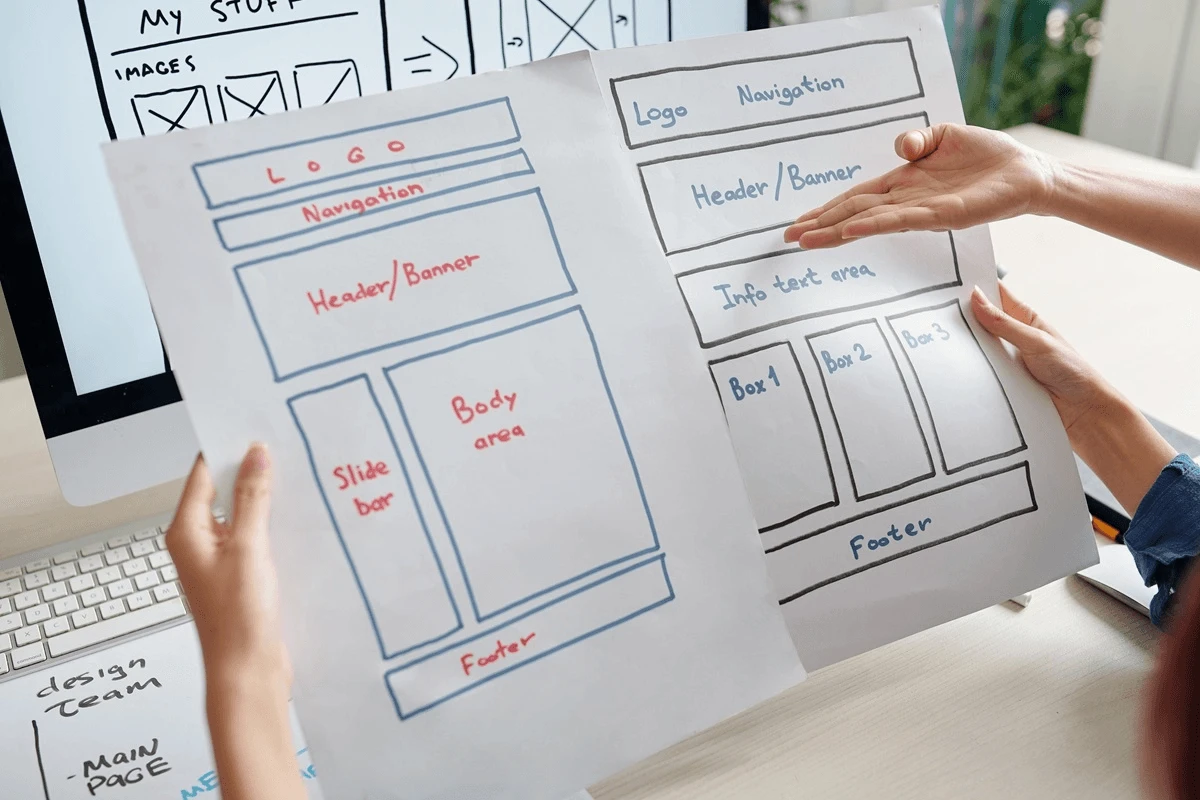Learning the essentials of website design doesn’t have to be difficult. With the right resources and guidance, grasping the fundamentals of creating a website can be an enjoyable and rewarding experience.
Are you looking to carve path in web design Whether you’re a budding artist, a career changer, or simply a tech enthusiast, we will break down everything you need to know on how to become a web designer, helping you kick-start your journey into the field. Dive in!
What is the Job Outlook for Web Designers?
The job outlook for web designers remains promising, driven by the increasing emphasis on online presence across industries. According to the recent report, employment opportunities for web designers as well as web developers are expected to grow 23% from 2021 to 2031. With businesses and individuals alike recognizing the importance of a well-designed website, there’s a growing demand for skilled professionals who can create visually appealing and user-friendly online experiences.
This demand is further fueled by trends such as the need for mobile-responsive designs, the expansion of e-commerce, and ongoing technological advancements in web development. Staying updated with industry trends and continuously honing skills in areas such as responsive design, UX/UI, and emerging technologies will be key for web designers to thrive in this dynamic field.
Web Designer Job Description
A web designer is responsible for creating the visual elements of websites, focusing on the overall layout, appearance, and user experience. Their job involves designing webpage layouts, graphics, icons, and other visual elements using software tools like Adobe Photoshop, Adobe Illustrator, or Sketch. They collaborate with clients or stakeholders to understand project requirements and objectives, then translate these into aesthetically pleasing and functional website designs.
Web designers also ensure that websites are user-friendly, accessible, and responsive across various devices and screen sizes. They may work closely with web developers to implement their designs using HTML, CSS, and other coding languages.
Related Article: Web Design vs Web Development: Which Career Suits You?
TYPES OF WEB DESIGNER CAREERS YOU CAN PURSUE
1. In-House Web Designer
In-house web designers are full-time employees directly hired by a single company or organization. They are in charge of developing and maintaining the company’s digital presence, including its website and other digital assets. Their primary focus is to ensure that the company’s digital platforms accurately reflect its brand identity, values, and objectives.
Skills:
In-house web designers need strong design skills, including proficiency with graphic design software and an understanding of web development technologies. They should also possess excellent communication and teamwork skills to collaborate effectively with cross-functional teams.
Responsibilities:
Their responsibilities include creating and updating the company’s website, designing digital assets such as graphics and multimedia content, and ensuring consistency in branding and user experience across all digital touchpoints. They may also be involved in strategic planning and long-term development of the company’s digital presence.
2. Agency Web Designer
Agency web designers work for design or digital marketing agencies, serving a diverse range of clients across various industries. They handle multiple projects simultaneously, ranging from website design and development to digital marketing campaigns. Their focus is on meeting the design needs and objectives of agency clients, which often include enhancing brand visibility, driving engagement, and increasing conversions. They adapt their design approach to accommodate different client preferences, brand guidelines, and project requirements.
Skills:
Agency web designers need to be adaptable and versatile, with strong design skills and the ability to work efficiently in a fast-paced environment. They should also possess excellent communication and client management skills to understand client needs and deliver high-quality design solutions.
Responsibilities:
Their responsibilities include collaborating with clients to understand their design requirements, creating visually appealing and functional designs, and working closely with other team members such as project managers, developers, and copywriters to ensure project success.

3. Freelance Web Designer
Freelance web designers are independent contractors who offer their design services to clients on a project-by-project basis. They have the flexibility to choose their projects, set their rates, and work remotely. Their focus is on delivering high-quality design solutions to clients while managing their own business operations. They have the freedom to select projects that align with their skills, interests, and schedule, allowing for a more flexible work-life balance.
Skills:
Freelance web designers need strong design skills, as well as business acumen to manage client relationships, negotiate contracts, and handle administrative tasks such as invoicing and project management. They should also possess self-discipline and time management skills to meet project deadlines effectively.
Responsibilities:
Their responsibilities include marketing their services to attract clients, negotiating project terms and fees, managing all aspects of the design process from initial client meetings to final delivery, and ensuring client satisfaction to maintain long-term relationships and referrals.
Essential Web Designer Skills
Web design is a multifaceted field that requires a combination of technical skills and soft skills If you’re wondering how to become a web designer, here are some essential skills to take note of:
Technical Skills
Graphic Design Tools
Web designers should be proficient in using graphic design software such as Adobe Creative Suite or Sketch to create visual elements for websites.
HTML/CSS
Knowledge of HTML and CSS is essential for web designers to understand the structure and styling of web pages. This enables them to effectively communicate with developers and implement design concepts.
Responsive Design
Understanding responsive design principles and techniques is crucial to ensure that websites are optimized for various devices and screen sizes, thus providing a consistent user experience across platforms.
UI/UX Design Principles
Familiarity with user interface (UI) and user experience (UX) design principles is important to create intuitive and user-friendly website layouts and interactions.
Typography and Color Theory
Knowledge of typography principles and color theory helps web designers create visually appealing and harmonious designs, enhancing readability and user engagement.
Image Editing
Skills in image editing software such as Adobe Photoshop or GIMP are essential for manipulating and optimizing images for use in web design.
Soft Skills
Creativity
Web designers should have a creative mindset to conceptualize and develop unique and visually engaging designs that effectively communicate the intended message or brand identity.
Attention to Detail
Attention to detail is critical for ensuring design elements are consistent, aligned, and visually appealing across all pages of a website.
Communication Skills
Effective communication skills are essential for collaborating with clients, stakeholders, and team members to understand project requirements, present design concepts, and incorporate feedback.
Time Management
Ability to manage multiple projects and prioritize tasks effectively to meet project deadlines and deliver high-quality work in a timely manner.

How to Become a Web Designer
Becoming a web designer involves a combination of education, practice, and staying updated with current trends and technologies. Here’s a general guide on how to become a web designer:
1. Learn the basics.
Start by understanding the basics of web design, including HTML, CSS, and JavaScript. These are the fundamental languages used to create web pages.
2. Take up relevant courses or get a degree.
While it’s possible to learn web design on your own through online tutorials and resources, formal education can provide structured learning and deeper understanding. Consider enrolling in a web design course at a college or university, or take online courses through platforms like Coursera, Udemy, or Codecademy.
3. Practice regularly.
Designing websites requires practice. Start by creating simple projects, and gradually move on to more complex ones. Experiment with different design styles, layouts, and functionalities.
4. Understand design principles.
Learn about design principles such as layout, typography, color theory, and user experience (UX) design. Understanding these principles will help you create visually appealing and user-friendly websites.
5. Master design tools.
Familiarize yourself with design tools such as Adobe Photoshop, Illustrator, or Sketch. These tools are commonly used in the web design industry for creating mockups, wireframes, and visual designs.
6. Acquire hands-on experience.
Consider freelancing or taking on internships to gain real-world experience and build your reputation in the industry.
7. Build a portfolio.
As you gain experience, create a portfolio showcasing your best work. Your portfolio is essential for demonstrating your skills and attracting potential clients or employers.
Launch Your Web Design Career with Confidence
Ready to turn your dream of becoming a successful web designer into reality? Let Infotech Resume be your partner in achieving your goals! Our expert team specializes in crafting technical resumes that showcase your unique skills and experiences in the field of web design. So, when you’re wondering how to become a web designer, start with our tailored resumes. You’re assured to stand out to potential employers and land the opportunities you’ve been dreaming of.
Don’t let your aspirations wait any longer – take the first step toward your web design career success. Get in touch now!





